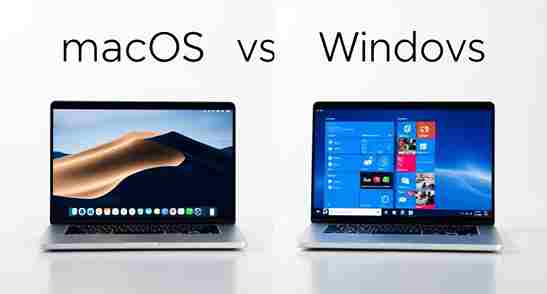What Does Recertified Mean is a question many buyers ask when shopping for electronics or home tools. You see it in product listings, training certificates, or even professional licenses. The term looks confusing, and people often assume it means “used” or “faulty.” In reality, recertified often signals items that passed inspection and earned approval again. It shows that quality checks, testing, and repairs happened before resale.
This truth is important, because recertified products can offer savings without hidden risks. Yet the word hides secrets that most shoppers never notice. In the next sections, you will see what recertified really means, where it applies, and why it can sometimes be the smartest choice.
What Does Recertified Mean in Simple Words?
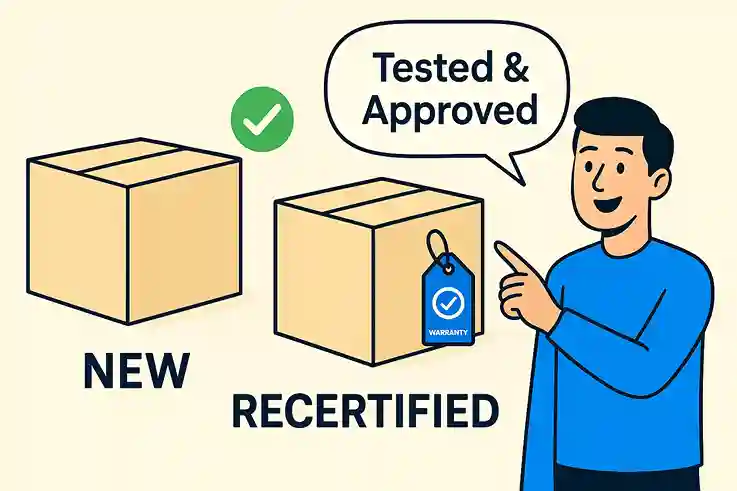
Recertified means experts take back a product, check it carefully, repair faults, and test it again before resale. The term shows the product did not leave the factory as new, but it also did not sit on a shelf as a risky used item.
A new product enters the market fresh from production, untouched by customers. A used product often comes with wear, hidden problems, or missing warranties. Recertified products create a third option. Sellers examine them, replace damaged parts, and confirm performance through testing. They then place the item back on the market with assurance.
This approach adds value because it blends lower cost with renewed reliability. You might see a phone labeled recertified after a return, a repair, and a full quality check. You might also see tools, appliances, or laptops offered the same way. The core idea stays simple: someone checked the product, someone fixed the problems, and someone verified it works as intended.
Recertification turns uncertainty into trust. It makes older stock useful again without lowering safety or performance.
The Process Behind Recertification
Recertification works through a clear process that follows strict standards. Each step adds trust, improves performance, and prepares the product for resale with confidence.
Inspection
Technicians begin the recertification process with a full inspection. They study the product inside and out, searching for scratches, dents, or broken parts, test every button, port, and feature to confirm proper function. They also check the internal systems, such as hardware components or software, depending on the product. This close review helps them separate minor issues from major faults. Careful inspection ensures they catch every problem early, so later repairs restore full quality and reliability.
Repair
When defects appear, technicians move straight to repair. They replace broken or worn parts with high-quality components and update outdated software to restore smooth performance. They adjust settings, tighten loose connections, and correct calibration issues. Each repair follows strict standards, so the finished product performs like it did when it left the factory. This stage turns problems into solutions and prepares the product for the next round of testing.
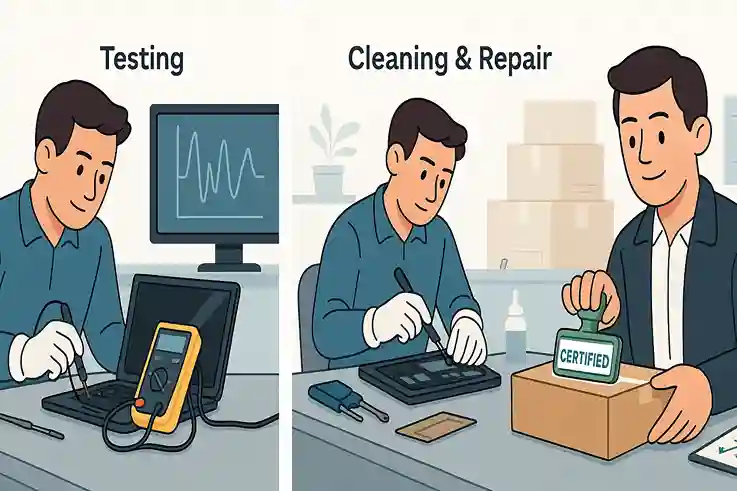
Testing
After repairs, the team runs detailed tests to confirm quality. They power up the product, use it under normal conditions, and push it through stress checks. They measure performance, accuracy, and safety to ensure nothing fails under pressure. By repeating these trials, they prove the product can handle daily use without issues. This stage gives buyers confidence because it shows the product performs as promised before it reaches the shelf again.
Packaging
Once tests confirm strong performance, staff clean the product carefully and remove signs of earlier use. They place it in fresh packaging with manuals, accessories, and protective wrapping. The product often looks nearly new, making it hard for buyers to notice any difference. Clear labels mark it as recertified, so buyers understand its history and the steps it passed through. This packaging stage closes the loop by presenting a product that feels new while staying honest about its journey.
Warranties and Guarantees
Sellers strengthen recertified products with warranties or guarantees. These promises give buyers confidence because they protect against future problems. A warranty may cover parts, repairs, or even full replacement if issues appear. Some sellers add a money-back guarantee to remove risk for the buyer. By offering these protections, sellers prove they trust the quality of their own work. They also show that recertification follows strict standards, not shortcuts. For many buyers, the warranty makes the difference between doubt and trust.
Common Areas Where You See Recertified Products
Recertification does not stay limited to one field. You see it in technology, household products, tools, and even professional training.
Electronics
Phones, laptops, and tablets often carry recertified labels. Technicians check batteries for charging strength, replace cracked screens, and test cameras, speakers, and ports. They run full system diagnostics to confirm smooth performance. They also update software so the device feels current. After these steps, buyers get electronics that work like new but cost far less. This balance of quality and savings makes recertified electronics one of the most popular choices on the market.
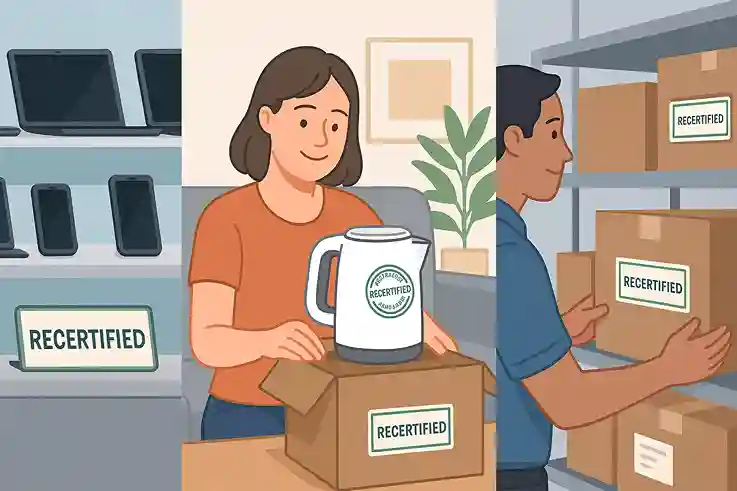
Appliances
Kitchen tools and home devices also appear as recertified. Coffee makers, blenders, and vacuum cleaners often go through repairs, cleaning, and safety checks before resale. Technicians replace filters, motors, or wiring if needed, and they test the appliances to ensure smooth operation. These steps keep performance consistent while lowering the price. Buyers save money, cut down on electronic waste, and still enjoy reliable products that fit daily life.
Tools and Equipment
Power drills, saws, and other equipment often go through recertification. Technicians replace worn parts, sharpen blades, and restore motors for full strength. They also test safety features such as guards, switches, and power cutoffs to ensure protection during use. These steps matter because tools face heavy wear in workshops and job sites. After recertification, homeowners gain reliable gear for projects, while professionals regain confidence in equipment they depend on daily.
Myths About Recertified Items
Many buyers avoid recertified products because they believe common myths. Clearing up these ideas shows the real value behind recertification.
Recertified Means Always Damaged
People often think recertified products carry hidden flaws that sellers try to cover up. In reality, technicians inspect every part, identify issues, and make direct repairs. They replace defective components, correct errors, and run full performance tests. The product must meet strict standards before it returns to the shelf. Instead of living with damage, buyers often receive an item that feels renewed, functions reliably, and sometimes performs better than a standard used product.
Recertified Means No Warranty
Another myth says sellers never give warranties on recertified items, leaving buyers with no protection. In truth, most trusted sellers include a warranty or a money-back guarantee. These promises cover repairs, replacements, or refunds if problems appear. They give buyers the same sense of security they expect from new products. When people ask What Does Recertified Mean, the answer includes more than just repairs—it also includes strong protection. By offering this coverage, sellers prove they trust the quality of their recertification process and stand behind the product with confidence.
Recertified Means Less Reliable
Some believe recertified items fail faster than new ones, but the opposite often proves true. When people ask What Does Recertified Mean, the answer points to testing, repair, and verification. Technicians check every system, fix defects, and run performance trials before the product returns to the shelf. These steps create consistency and trust. In many cases, recertified products perform more reliably than typical used items sold without inspection. Buyers gain solid value, proven quality, and peace of mind.
“Recertified products prove that quality doesn’t have to mean brand new — it just has to mean trusted, tested, and reliable.”
The Real Benefits of Buying Recertified
When people wonder What Does Recertified Mean, they often overlook the practical benefits. Recertified products bring value in ways that new and used items cannot match.
Cost Savings
Recertified products usually cost much less than brand-new versions, sometimes offering savings of 20% to 50%. Buyers spend less but still receive items that pass inspections and testing. This combination delivers value without forcing a compromise on quality. Shoppers on a budget—like students, families, or small businesses—gain access to reliable products they might not afford at full price. The lower cost paired with proven performance makes recertification one of the smartest buying choices available.
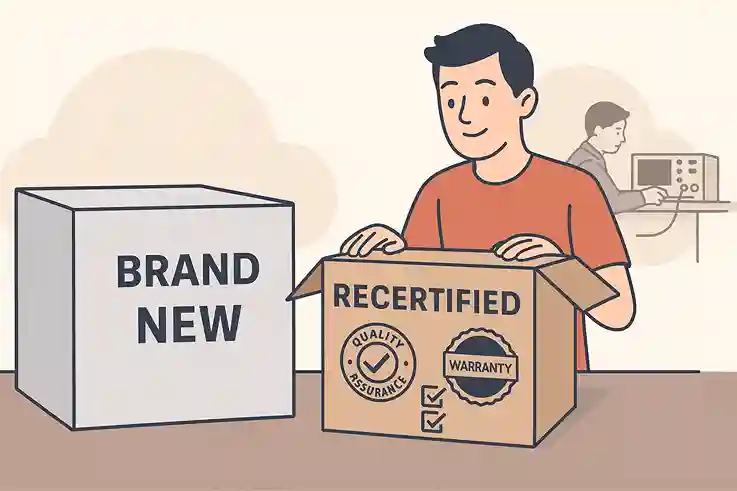
Sustainability and Reduced Waste
Buying recertified helps the environment in powerful ways. Every repaired and reused product avoids landfills and reduces the growing problem of electronic waste. Fewer discarded items also mean less demand for new raw materials, energy, and packaging. This choice supports sustainability without sacrificing performance or convenience. Shoppers meet their own needs while also lowering their environmental footprint. By choosing recertified, buyers save money and protect the planet at the same time.
Assurance of Quality Checks
Technicians inspect, repair, and test every recertified product before resale. They run performance checks, verify safety features, and confirm the item meets high standards. These steps prove the product’s quality and give buyers real confidence. Unlike used items sold casually, recertified products receive professional approval backed by warranties or guarantees. This process turns uncertainty into trust and makes recertification a safer path for smart buyers.
Safer Than Used Items
Used items sold “as is” often carry unknown risks, from hidden damage to missing parts. Buyers usually have no way to confirm safety or reliability. Recertified products, however, go through structured repairs and strict testing before reaching the shelf. Technicians replace faulty components, verify safety features, and check performance under real conditions. These steps make recertified products far safer than random used items. Buyers enjoy performance close to new, plus the added security of warranties or guarantees.
Secrets You Should Know Before Buying Recertified
When people ask What Does Recertified Mean, they often stop at the definition. The truth is, buyers should also know a few secrets before making a purchase. These tips help you get the best value and avoid mistakes.
Always Check Warranty Length
Not all warranties last the same amount of time, and that detail makes a big difference. Some sellers cover recertified products for only 90 days, while others match the one-year coverage offered with new items. A few trusted brands even extend coverage beyond a year to show extra confidence. Always read the terms before you buy, so you know exactly how much protection you receive. A longer warranty not only adds confidence but also proves the seller believes in the quality of their recertification process.
Buy Only From Trusted Sellers
Choose retailers or manufacturers with a strong reputation, because reputation usually reflects reliability. Trusted sellers follow strict recertification steps, repair products with care, and test them against clear standards. They also honor warranties and provide customer support when problems arise. Unknown sellers, on the other hand, may cut corners, skip inspections, or ignore promises after the sale. Buying from them adds risk and reduces value. A trusted source gives you confidence that the product truly went through recertification, not just a quick cleanup.
Compare Price vs. New and Used
Recertified items should always deliver real savings, not just a small discount. If the price sits too close to brand-new, the deal loses its value because buyers can often stretch a little more for untouched products. If the cost rises above a used item, the difference must come from warranties, repairs, and quality checks. Smart buyers compare all three options—new, used, and recertified—before making a choice. That comparison ensures they get both the savings they want and the protection they need.
Look for Certification Labels
Labels matter more than most buyers realize. Many products include seals, tags, or official marks that confirm successful recertification. These labels show the item passed inspections, repairs, and testing under clear standards. Without them, the product might only be used, not truly recertified. Always look for proof, because a proper label separates trusted quality from risky guesswork. When buyers see that certification mark, they know the product carries both testing and accountability.
For recertified products, Apple officially calls them Certified Refurbished in the USA. Here’s the direct link to their store:
When to Choose Recertified Over New
What Does Recertified Mean goes beyond simple definition—it also points to smart buying choices. Recertified products do not always replace new ones, but in many situations they make the smarter option. Knowing when to choose recertified helps buyers get maximum value without giving up reliability.
Best for Budget-Conscious Buyers
If you want high performance at a lower cost, recertified makes sense. Budget-conscious buyers save money while still getting products that technicians inspect, repair, and test for reliability. This choice stretches every dollar without requiring a sacrifice in quality. Instead of settling for outdated or lower-tier models, buyers can often afford higher-end options through recertification. The combination of savings, performance, and warranty support makes this path especially attractive for families, small businesses, or anyone watching expenses closely.
Good for Students and Home Users
Students often need laptops, tablets, or tools for schoolwork, projects, and research. New devices can feel out of reach on a tight budget, but recertified options bridge the gap. These products deliver dependable performance for assignments, presentations, and online classes without draining savings.
Home users also benefit from recertified appliances, electronics, and tools. Families can buy kitchen devices, entertainment systems, or home repair equipment that perform well while costing far less than new. This choice frees up money for other essentials and still provides reliable products that support everyday life.
Safe if Backed by Warranty and Support
Warranty coverage and strong support make recertified products safe to buy. A trusted seller stands behind the item with clear protection that covers repairs, parts, or even full replacements when problems appear. Buyers know they can reach out for help instead of worrying about unexpected costs. This safety net removes doubt and turns a lower-priced purchase into a risk-free decision. When combined with savings and quality checks, the warranty makes recertified products just as dependable as new ones—sometimes even more so.
Recertified vs. Refurbished
Many buyers ask What Does Recertified Mean and often confuse it with refurbished. Both involve repairs and testing, but they do not always mean the same thing.
Refurbished items usually return after defects, minor wear, or customer dissatisfaction. Sellers repair them, clean them, and test them before resale. The process restores the product, but quality can vary depending on who handled the refurbishment.
Recertified products go further. After repair and testing, they receive official certification that proves they meet strict quality standards. Labels and warranties confirm this certification, giving buyers more protection.
In simple terms:
- Refurbished = repaired and resold.
- Recertified = repaired, tested, and certified to meet higher standards.
When people ask What Does Recertified Mean, the difference becomes clear. Recertified products combine lower prices with the trust of certification, making them safer than most refurbished items.
| Feature | Refurbished | Recertified |
|---|---|---|
| Process | Repaired, cleaned, and tested | Repaired, tested, and officially certified |
| Standards | Vary by seller or third party | Follow strict manufacturer or seller standards |
| Warranty | Sometimes included, sometimes not | Almost always included with clear terms |
| Labels/Proof | May not include official labels | Comes with seals, tags, or certificates |
| Buyer Confidence | Depends on seller reputation | Higher confidence due to certification |
| Best For | Bargain hunters willing to take some risk | Buyers who want both savings and guaranteed reliability |
FAQs About What Does Recertified Mean
Conclusion On What Does Recertified Mean
What Does Recertified Mean is more than just a label. It represents a process of inspection, repair, and testing that restores products to dependable condition. Recertification gives buyers a middle ground between new and used, combining lower prices with proven reliability. From electronics to appliances and tools, recertified items deliver real value. They save money, reduce waste, and often come with warranties that remove risk. Buyers who choose recertified gain both quality and confidence. The next time you see a product marked as recertified, remember the benefits behind the word. You may discover that the smarter choice does not always mean buying new.
Have you ever bought a recertified product? Share your experience in the comments — your story might help someone else make a smarter decision.

Amina Pierce is a tech-savvy blogger with a specialty in electronics, where she shares practical insights on gadgets, innovations, and the latest trends shaping our digital world. With a strong interest in how technology impacts everyday life, she breaks down complex topics into clear, easy-to-understand articles for readers of all backgrounds. While electronics is her main focus, Amina also enjoys writing on a variety of other subjects, including lifestyle, travel, and personal growth, making her content both diverse and engaging.
Outside of blogging, Amina loves tinkering with new devices, exploring smart home solutions, and capturing her experiences through travel photography. Her blend of technical knowledge and approachable style makes her a trusted source of information and inspiration.


